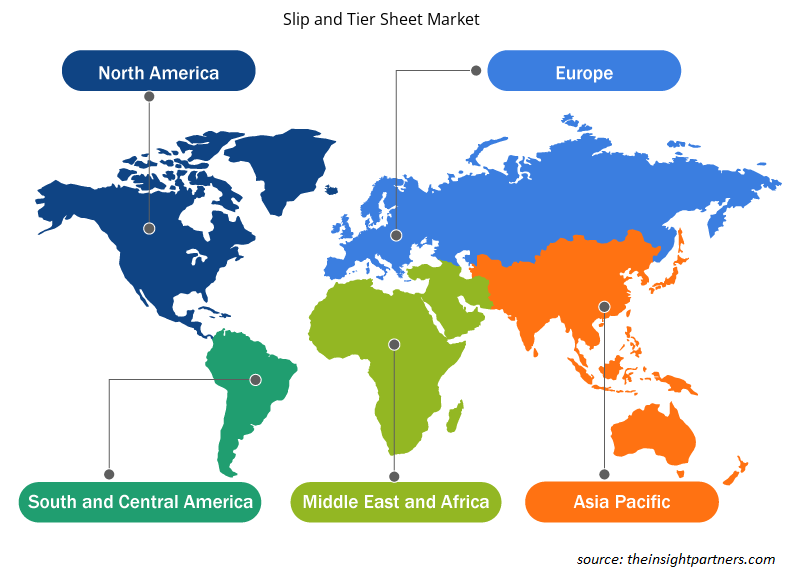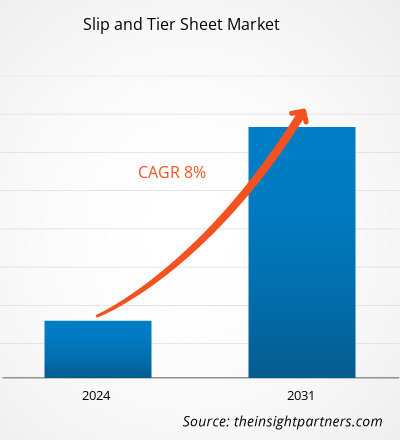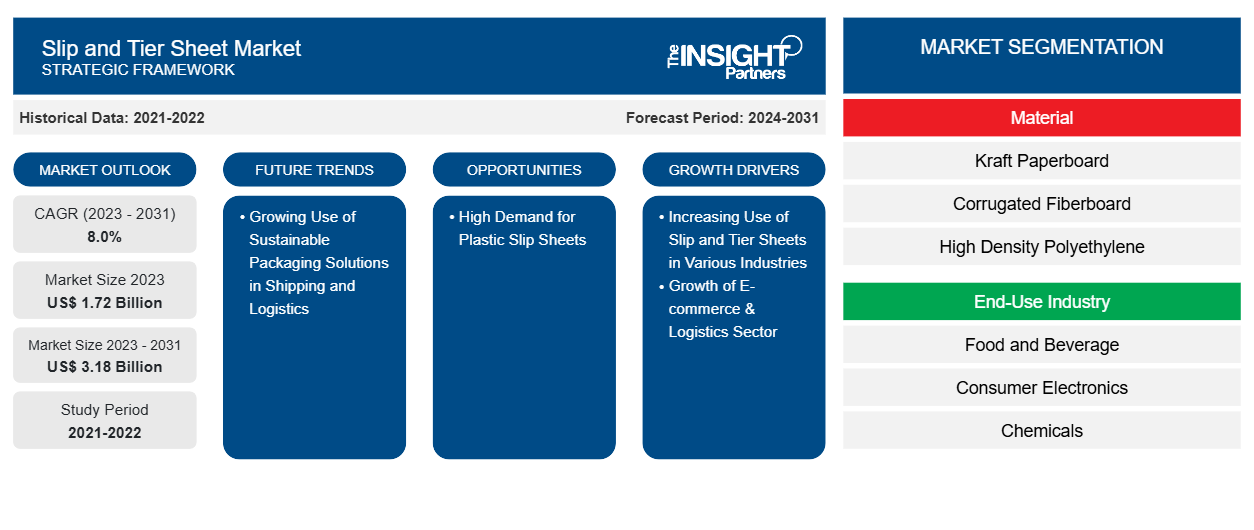Le marché des plaques à glissement et à paliers devrait passer de 1,72 milliard USD en 2023 à 3,18 milliards USD en 2031 ; il devrait enregistrer un TCAC de 8,0 % de 2023 à 2031.
Informations sur le marché et point de vue des analystes :
Les feuilles de glissement et de niveau sont des alternatives abordables aux palettes en bois. Ces feuilles occupent moins d'espace que les palettes en bois et permettent de transporter plus de chargements de camions, ce qui permet aux entreprises d'économiser sur les dépenses logistiques. Les feuilles de glissement et de niveau sont généralement fabriquées en papier kraft, en carton ondulé, en polyéthylène haute densité et en polypropylène. Les fabricants conçoivent les feuilles de glissement en fonction du nombre d'extensions de lèvres qui se connectent au dispositif de chargement. Les deux types fondamentaux de feuilles de glissement sont à lèvres simples et à lèvres multiples. La feuille de glissement fabriquée à partir d'un carton ondulé se compose de deux surfaces de doublure avec un intérieur ondulé collé avec de l'adhésif ou de la colle. Les feuilles de glissement fabriquées à partir de carton ont un poids de base et une densité élevés. Elles sont produites en plusieurs couches laminées ensemble, et cette liaison permet l'utilisation des feuilles plusieurs fois dans des environnements de température différents. Les feuilles de glissement en plastique sont fabriquées à partir de polymères thermoplastiques ou thermodurcissables. Les feuilles de glissement et de niveau en plastique deviennent de plus en plus populaires car elles sont abordables, ont une résistance élevée, conviennent à la manutention de matériaux lourds et offrent un support structurel solide aux produits. Les entreprises proposent des feuilles de glissement qui ont des dimensions spécifiées de longueur, de largeur et d'épaisseur. Les plaques à étages sont disponibles en différentes tailles. De plus, les entreprises opérant sur le marché fournissent des plaques à étages et à étages dans n'importe quelle taille personnalisée.
Moteurs de croissance et défis :
L'utilisation croissante de feuilles de glissement et de couches dans diverses industries contribue à la croissance du marché des feuilles de glissement et de couches . La feuille de glissement est une alternative fine et légère aux palettes en bois. Les feuilles de glissement sont beaucoup plus légères que les palettes ; leur utilisation pour le transport ou le stockage est beaucoup plus facile. Elles permettent d'économiser plus d'espace par rapport aux palettes traditionnelles, ce qui permet aux utilisateurs d'exporter plus de produits. Par conséquent, un espace de stockage réduit et une conception légère des feuilles de glissement contribuent à réduire les coûts de transport. Les feuilles de glissement contribuent également à réduire les émissions de carburant car elles sont plus légères à transporter que les palettes en bois. Elles sont facilement recyclables, respectueuses de l'environnement, polyvalentes et peuvent être utilisées dans des environnements froids et humides. Il existe un risque élevé d'infestations de rongeurs et de contamination par les palettes en bois. Cependant, en raison de la finesse de la feuille de glissement, les rongeurs n'occupent pas la zone située en dessous, ce qui conduit à un entrepôt plus propre. Les utilisateurs peuvent facilement jeter la feuille de glissement et éviter l'accumulation de contamination au fil du temps. De plus, les feuilles de glissement deviennent très populaires à mesure que les entreprises réalisent leur potentiel de retour sur investissement. Ainsi, les avantages de l'utilisation de feuilles de glissement par rapport aux palettes entraînent une demande accrue de produits dans différentes industries d'utilisation finale. De plus, les feuilles intercalaires sont fabriquées à partir de papier 100 % recyclé . Ces feuilles sont disponibles dans différentes tailles compatibles avec tous les types de palettes. Les feuilles intercalaires sont durables et peuvent également être utilisées dans des conditions difficiles. En raison des avantages des feuilles intercalaires, l'utilisation de ces feuilles se développe dans l'emballage de bouteilles de boissons, de canettes, de conteneurs, de biens de consommation, de produits et pièces industriels, d'aliments transformés, de produits laitiers et de produits secs tels que les sels, les céréales et les ingrédients. Les tendances du marché des feuilles intercalaires et intercalaires incluent l'utilisation croissante de solutions d'emballage durables dans le transport et la logistique.
L'utilisation de feuilles de glissement présente quelques inconvénients. Les clients doivent acheter ou louer un équipement différent pour manipuler les feuilles de glissement, car les chariots élévateurs standard ne fonctionneront pas. Lorsque les feuilles de glissement sont utilisées en remplacement direct des palettes, il est nécessaire d'utiliser un accessoire de poussée/traction pour le chariot élévateur, ce qui est coûteux. De plus, la manipulation sûre de ces accessoires nécessite une expertise et une formation adéquate. De plus, dans une certaine mesure, les feuilles de glissement ne sont pas capables de supporter des produits lourds. Le support structurel fourni par les feuilles de glissement est inférieur à celui fourni par les palettes, et elles ne supportent pas autant de poids que les palettes. Par conséquent, elles ne constituent pas une option adaptée aux entreprises qui expédient des produits lourds. De plus, les feuilles de glissement ondulées seront affaiblies si elles entrent en contact avec l'eau et l'humidité et ne conviennent donc pas aux chaînes d'approvisionnement réfrigérées. Ces inconvénients associés à l'utilisation de feuilles de glissement freinent la croissance du marché mondial des feuilles de glissement et de glissement.
Personnalisez ce rapport en fonction de vos besoins
Vous bénéficierez d'une personnalisation gratuite de n'importe quel rapport, y compris de certaines parties de ce rapport, d'une analyse au niveau des pays, d'un pack de données Excel, ainsi que de superbes offres et réductions pour les start-ups et les universités.
-
Obtenez les principales tendances clés du marché de ce rapport.Cet échantillon GRATUIT comprendra une analyse de données, allant des tendances du marché aux estimations et prévisions.
Segmentation et portée du rapport :
L'analyse du marché mondial des plaques de glissement et de niveau a été réalisée en prenant en compte les segments suivants : matériau, industrie d'utilisation finale et géographie. En fonction du matériau, le marché est segmenté en carton kraft, carton ondulé, polyéthylène haute densité et autres. Par industrie d'utilisation finale, le marché est segmenté en aliments et boissons, électronique grand public , produits chimiques, produits pharmaceutiques, vente au détail et autres. La portée géographique du rapport sur le marché des plaques de glissement et de niveau se concentre sur l'Amérique du Nord (États-Unis, Canada et Mexique), l'Europe (Allemagne, France, Italie, Royaume-Uni, Russie et reste de l'Europe), l'Asie-Pacifique (Australie, Chine, Japon, Inde, Corée du Sud et reste de l'Asie-Pacifique), le Moyen-Orient et l'Afrique (Afrique du Sud, Arabie saoudite, Émirats arabes unis et reste du Moyen-Orient et de l'Afrique) et l'Amérique du Sud et centrale (Brésil, Argentine et reste de l'Amérique du Sud et centrale).
Analyse segmentaire :
En fonction du matériau, le marché des feuilles de glissement et de niveau est segmenté en carton kraft, carton ondulé, polyéthylène haute densité et autres. En fonction du matériau, le segment du carton kraft devrait détenir une part de marché importante des feuilles de glissement et de niveau d'ici 2031. Le carton kraft est rendu imperméable en le doublant soit de polyéthylène, soit d'une couche de bitume écologique. Il est rentable et léger ; par conséquent, il est utilisé pour protéger et emballer les produits pendant le transport. Les feuilles de carton kraft protègent les produits en vrac en boîte et en sac contre les déchirures et les perforations causées par les clous de palette et les planches de terrasse. Les cartons kraft sont utilisés dans de nombreuses applications, notamment les points de restauration rapide et la production de présentoirs de points de vente. Le carton ondulé est également l'un des principaux matériaux du marché des feuilles de glissement et de niveau. Un carton ondulé est une structure sandwich formée en collant une ou plusieurs feuilles de matériaux cannelés et ondulés sur une ou plusieurs faces plates du carton de doublure. L'emballage en carton ondulé est polyvalent, économique, léger, robuste, recyclable et dynamique. Les cartons ondulés sont généralement utilisés pour l'emballage de biens de consommation. Ils offrent une meilleure résistance aux forces de compression, une plus grande rigidité à la flexion et une plus grande résistance à l'humidité. Les cartons sont généralement conçus sur mesure pour répondre aux exigences spécifiques des clients.
Analyse régionale :
Français Sur la base de la géographie, le marché est segmenté en cinq régions clés : l'Amérique du Nord, l'Europe, l'Asie-Pacifique, l'Amérique du Sud et l'Amérique centrale, et le Moyen-Orient et l'Afrique. En termes de revenus, l'Amérique du Nord a dominé la part de marché mondiale des plaques de glissement et de niveau. Le marché en Amérique du Nord représentait environ 650 millions de dollars américains en 2023. Le marché des plaques de glissement et de niveau en Amérique du Nord est principalement motivé par leur utilisation croissante dans différentes industries d'utilisation finale. Selon le Bureau of Transportation Statistics, le fret transfrontalier en Amérique du Nord a augmenté de 24,1 % en août 2022 par rapport à août 2021. La croissance du fret transfrontalier est l'un des principaux facteurs qui stimulent le marché des plaques de glissement et de niveau en Amérique du Nord. Les plaques de glissement et de niveau sont des matériaux minces qui consomment beaucoup moins d'espace que les palettes et pèsent beaucoup moins que les palettes. Ainsi, les entreprises de transport et les fabricants préfèrent les plaques de glissement et de niveau aux granulés de bois, ce qui alimente la croissance du marché dans la région.
L'Europe est un autre contributeur majeur, détenant plus de 30 % de la part de marché mondiale. Le marché européen des plaques de recouvrement et des plaques intercalaires connaît une croissance considérable en raison de la croissance de l'industrie de la logistique et de la hausse de la demande de produits d'emballage. Selon la Commission européenne, en 2021, le transport routier de marchandises en Europe a fortement augmenté de 6,5 % par rapport à 2020. L'augmentation des activités commerciales stimule la demande globale de matériaux d'emballage à travers l'Europe. De plus, entre 2019 et 2021, la demande annuelle moyenne de produits pharmaceutiques a été la plus élevée pour les équipements de test de diagnostic, les consommables médicaux, les dispositifs médicaux et les vêtements de protection. La croissance significative des industries d'utilisation finale telles que les produits pharmaceutiques, l'agriculture et la vente au détail en Europe propulse la croissance du marché des plaques de recouvrement et des plaques intercalaires en Europe.
Aperçu régional du marché des plaques à glissement et à paliers
Les tendances et facteurs régionaux influençant le marché des plaques de recouvrement et des plaques de recouvrement tout au long de la période de prévision ont été expliqués en détail par les analystes d'Insight Partners. Cette section traite également des segments et de la géographie du marché des plaques de recouvrement et des plaques de recouvrement en Amérique du Nord, en Europe, en Asie-Pacifique, au Moyen-Orient et en Afrique, ainsi qu'en Amérique du Sud et en Amérique centrale.

- Obtenez les données régionales spécifiques au marché des plaques de glissement et de palier
Portée du rapport sur le marché des plaques de recouvrement et des plaques à étages
| Attribut de rapport | Détails |
|---|---|
| Taille du marché en 2023 | 1,72 milliard de dollars américains |
| Taille du marché d'ici 2031 | 3,18 milliards de dollars américains |
| Taux de croissance annuel composé mondial (2023-2031) | 8,0% |
| Données historiques | 2021-2022 |
| Période de prévision | 2024-2031 |
| Segments couverts |
Par matériau
|
| Régions et pays couverts |
Amérique du Nord
|
| Leaders du marché et profils d'entreprises clés |
|
Densité des acteurs du marché des feuilles de transfert et des feuilles de transfert : comprendre son impact sur la dynamique des entreprises
Le marché des plaques à glissières et à étages connaît une croissance rapide, tirée par la demande croissante des utilisateurs finaux en raison de facteurs tels que l'évolution des préférences des consommateurs, les avancées technologiques et une plus grande sensibilisation aux avantages du produit. À mesure que la demande augmente, les entreprises élargissent leurs offres, innovent pour répondre aux besoins des consommateurs et capitalisent sur les tendances émergentes, ce qui alimente davantage la croissance du marché.
La densité des acteurs du marché fait référence à la répartition des entreprises ou des sociétés opérant sur un marché ou un secteur particulier. Elle indique le nombre de concurrents (acteurs du marché) présents sur un marché donné par rapport à sa taille ou à sa valeur marchande totale.
Les principales entreprises opérant sur le marché des plaques à glissement et à paliers sont :
- Fresh Pak Corp
- Société Internationale de Papier
- Georgia-Pacific LLC
- Groupe industriel Signode LLC
- WestRock Co
- Dura-Fibre SARL
Avis de non-responsabilité : les sociétés répertoriées ci-dessus ne sont pas classées dans un ordre particulier.

- Obtenez un aperçu des principaux acteurs du marché des plaques de recouvrement et des plaques de recouvrement
Développements de l'industrie et opportunités futures :
Les prévisions du marché des feuilles de glissement et de niveau peuvent aider les parties prenantes à planifier leurs stratégies de croissance. Voici les initiatives prises par les principaux acteurs opérant sur le marché :
- En septembre 2023, Sonoco Products Co a annoncé la finalisation de l'acquisition de la participation restante dans RTS Packaging, LLC auprès de son partenaire de coentreprise WestRock et d'une usine de papier WestRock à Chattanooga, dans le Tennessee. Cette acquisition renforcera et élargira encore les solutions d'emballage à base de fibres 100 % recyclées de Sonoco pour servir les marchés en pleine croissance des vins, spiritueux, aliments, produits de beauté et soins de santé. Avec cette acquisition, Sonoco ajoute un réseau de 15 opérations et 1 100 employés aux États-Unis, au Mexique et en Amérique du Sud.
- En novembre 2021, Badger Paperboard, une entreprise de transformation de panneaux de particules basée à Fredonia, dans le Wisconsin, a annoncé l'acquisition de Falcon Packaging à Houston, au Texas. L'ajout des installations complètes de transformation et d'entreposage de Falcon Packaging à Houston permettra d'étendre l'empreinte et les capacités de production de Badger.
Paysage concurrentiel et entreprises clés :
Fresh Pak Corp, International Paper Co, Georgia-Pacific LLC, Signode Industrial Group LLC, WestRock Co, Dura-Fibre LLC, Smurfit Kappa Group Plc, Crown Paper Converting, Eltete TPM Oy et Sonoco Products Co font partie des principaux acteurs présentés dans le rapport sur le marché des plaques à glissière et à étages. Les acteurs opérant sur le marché mondial se concentrent sur la fourniture de produits de haute qualité pour répondre à la demande des clients. En outre, ils se concentrent sur l'adoption de diverses stratégies telles que le lancement de nouveaux produits, l'extension de capacité, les partenariats et les collaborations afin de rester compétitifs sur le marché des plaques à glissière et à étages.
- Analyse historique (2 ans), année de base, prévision (7 ans) avec TCAC
- Analyse PEST et SWOT
- Taille du marché Valeur / Volume - Mondial, Régional, Pays
- Industrie et paysage concurrentiel
- Ensemble de données Excel
Rapports récents
Témoignages
Raison d'acheter
- Prise de décision éclairée
- Compréhension de la dynamique du marché
- Analyse concurrentielle
- Connaissances clients
- Prévisions de marché
- Atténuation des risques
- Planification stratégique
- Justification des investissements
- Identification des marchés émergents
- Amélioration des stratégies marketing
- Amélioration de l'efficacité opérationnelle
- Alignement sur les tendances réglementaires























 Obtenez un échantillon gratuit pour - Marché des feuilles à glissement et à paliers
Obtenez un échantillon gratuit pour - Marché des feuilles à glissement et à paliers